Punjab State Board PSEB 10th Class Science Book Solutions Chapter 6 Life Processes Textbook Exercise Questions and Answers.
PSEB Solutions for Class 10 Science Chapter 6 Life Processes
PSEB 10th Class Science Guide Life Processes Textbook Questions and Answers
Question 1.
The kidneys in human beings are a part of the system for :
(a) nutrition
(b) respiration
(c) excretion
(d) transportation.
Answer:
(c) excretion.
Question 2.
The xylem in plants are responsible for :
(a) transport of water
(b) transport of food
(c) transport of amino acids
(d) transport of oxygen.
Answer:
(a) transport of water.
Question 3.
The autotrophic mode of nutrition requires :
(a) CO2 and water
(b) Chlorophyll
(c) Sunlight
(d) All of the above.
Answer:
(d) All of above.
Question 4.
The breakdown of pyruvate to give CO2, water and energy takes place in :
(a) cytoplasm
(b) mitochondria
(c) chloroplast
(d) nucleus
Answer:
(b) mitochondria.
Question 5.
How are fats digested in our bodies? Where does the process take place?
Answer:
Digestion of fats takes place in the intestine. The fats are emulsified by the bile salts present in bile. The emulsified fats are acted upon by pancreatic lipase (strepsin) which hydrolyses fats into fatty acids and glycerol. The intestinal lipase also hydrolyses the emulsified fats into fatty acids and glycerol.

Question 6.
What is the role of saliva in the digestion of food?
Answer:
Role of saliva
- Saliva lubricates the food and facilitates mastication.
- Saliva binds the food molecules together.
- Saliva contains ptyalin (salivary amylase) enzyme which acts on starch, glycogen and other carbohydrates to form maltose.
![]()
Question 7.
What are the necessary conditions for autotrophic nutrition and what are its byproducts?
Answer:
Photosynthesis is essential in case of autotrophic nutrition
![]()
Conditions required for photosynthesis
- CO2 is necessary for photosynthesis.
- Water is required.
- Sunlight is necessary for photosynthesis.
- Chlorophyll is essential for photosynthesis.
- By-products. Molecular oxygen is liberated as a byproduct.
Question 8.
What are the differences between aerobic respiration and anaerobic respiration? Name some organisms that use anaerobic mode of respiration.
Answer:
(a) Differences between aerobic and anaerobic respiration
| Aerobic respiration | Anaerobic respiration |
| 1. It takes place in the presence of oxygen. | 1. It takes place in the absence of oxygen. |
| 2. It is completed in cytoplasm and mitochondria of cells. | 2. It is completed in the cytoplasm only. |
| 3. It involves the complete oxidation of glucose into CO2 and H2O and a large amount of energy is released. | 3. It involves the incomplete oxidation of glucose into CO2 and alcohol or lactic acid and less amount of energy is released. |
| 4. The process is harmless. | 4. It is toxic to plants. |
(b) Anaerobic respiration takes place in bacteria and yeast.
Question 9.
How are alveoli designed to maximise the exchange of gases?
Answer:
Question 10.
What would be the consequences of a deficiency of haemoglobin in our bodies?
Answer:
Haemoglobin is a respiratory pigment present in RBC of blood. It has high affinity for oxygen. One molecule of haemoglobin carries 4 molecules of oxygen. If simple diffusion were to move oxygen in our body, it is estimated that it would take 3 years for a molecule of oxygen to reach tip of toes from lungs.
Question 11.
Describe double circulation in human beings. Why is it necessary?
Answer:
Double circulation. In human beings heart is four-chambered, having right and left auricles and right and left ventricles. The right auricle receives the deoxygenated blood from the body and sends it into the right ventricle that pumps it to the lungs via a pulmonary arch for oxygenation. The left auricle receives oxygenated blood from the lungs and sends it into the left ventricle, which pumps it to the body through a single aortic arch.
Significance:
- Thus, the deoxygenated and oxygenated blood remain fully separate, and there is complete double circulation.
- It increases efficiency.
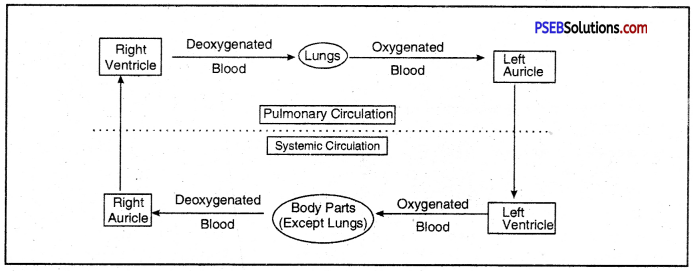
Double circulation of blood in birds and mammals.
Question 12.
What are the differences between the transport of materials in xylem and phloem?
Answer:
Differences between transport in xylem and phloem
| Transport in xylem | Transport in phloem |
| 1. Water and minerals are transported through xylem. | 1. Sucrose, amino acids and other substances are transported through phloem. |
| 2. Xylem helps in upward movement, i.e. from roots to stem, branches and leaves. | 2. Phloem is responsible for downward and lateral movement from leaves to other parts. |
Question 13.
Compare the functioning of alveoli in the lungs and nephrons in the kidneys with respect to their structure and functioning.
Answer:
- Alveoli of lungs remove CO2 as a waste during exchange of gases and nephrons filter wastes from blood.
- Alveoli are supplied with extensive network of blood capillaries for gaseous exchange. Bowman’s capsule surrounds a cluster of capillaries for filtration.
- Both increases surface area either for gaseous exchange or filtration.
- Urea and uric acid wastes are removed in the nephron.
- Both purify blood lungs alveoli by removing waste gases and nephrons by filtering the waste products in the form of urine.
Science Guide for Class 10 PSEB Life Processes InText Questions and Answers
Question 1.
Why is diffusion insufficient to meet the energy requirements of multicellular organisms like humans?
Answer:
In multicellular organisms, all the cells of body may not be in direct contact with the surrounding source of oxygen i.e. environment, thus simple diffusion will not meet the oxygen requirements of all the cells. These organisms require specialised organs to meet the oxygen requirement.
![]()
Question 2.
What criteria do we use to decide whether something is alive?
Answer:
Features of living organisms
- Movements
- Growth
- Metabolism
- Cellular body
- Nutrition
- Respiration
- Transportation
- Excretion
- Respond to stimuli
- Reproduction.
Question 3.
What are outside raw materials used by living organism?
Answer:
Outside raw materials used by living organism
- Energy obtained from food.
- Oxygen: Required for breaking down of carbon based molecules to liberate energy in the body.
- Water: It is required for proper digestion of food and other functions in the body. It is raw material for photosynthesis in plants. All reactions occur in solution form in the body.
- CO2 Raw material for photosynthesis in plants. All reactions occur in solution form in the body.
Question 4.
What processes would you consider essential for maintaining life?
Answer:
- Nutrition
- Respiration
- Transportation
- Excretion.
Question 5.
What are the differences between autotrophic and heterotrophic nutrition?
Answer:
Differences between Autotrophic and Heterotrophic nutrition
| Autotrophic Nutrition | Heterotrophic Nutrition |
| 1. It occurs in green plants and blue green algae. | 1. It occurs in animals and insectivorous plants. |
| 2. CO2 and water are raw materials which combine to form organic compound. | 2. They depend on plants and herbivore for their food. |
| 3. They need chlorophyll and sunlight | 3. There is no need of chlorophyll and sunlight, |
Question 6.
Where do the plants get each of raw materials required for photosynthesis? (PB. Board 2011)
Answer:
Raw materials of photosynthesis
- CO2
- Water.
- Nitrogen
- CO2 is obtained from air. It enters the leaf through stomatal openings.
- Water is obtained from soil. It enters the leaf through the mid-rib and vein from the root which absorbs it from the soil.
- Nitrogen: It is obtained from soil.
Question 7.
What is the role of acid in our stomach?
Answer:
HCl is obtained from gastric glands present in the wall of the stomach.
Functions of HCl:
- It provides acidic medium. It is required for the action of enzymes. It changes the pH of food from almost neutral to acidic medium (from pH 7 to 2)
- Activates the inactive proenzyme propepsin into active pepsin.
- Kills the bacteria present in food.
- It softens calcium.
- It regulates the opening and closing of the pyloric aperture.
Question 8.
What is the function of digestive enzymes?
Answer:
Role of digestive enzymes: These enzymes convert the complex non-diffusible form of food into simple diffusible form.
- Ptyalin converts starch into maltose.
- Pepsin breaks down proteins into peptides and amino acids.
- Rennin curdles milk protiens so that they can stay for longer period to be acted upon by pepsin.
- Lipase acts on fats and forms fatty acid and glycerol.
- Maltase acts on maltose and forms glucose.
Question 9.
How is small intestine designed to absorb digested food?
Answer:
Small intestine is a long tubular structure. The inner wall of small intestine is thrown into folds called villi. The absorptive cells have numerous finger-like processes called microvilli. They increase the surface area for absorption of food. These villi have blood vessels named lacteals from absorption of food.
Question 10.
What advantage over an aquatic organism does a terrestrial organism have with regard to obtaining oxygen for respiration?
Answer:
The amount of oxygen dissolved in water is very low as compared to the amount of oxygen in air. Thus these organisms have to make less efforts to obtain oxygen.
![]()
Question 11.
What are the different ways in which glucose is oxidised to provide energy in various organisms?
Answer:
Different pathways to provide energy from glucose
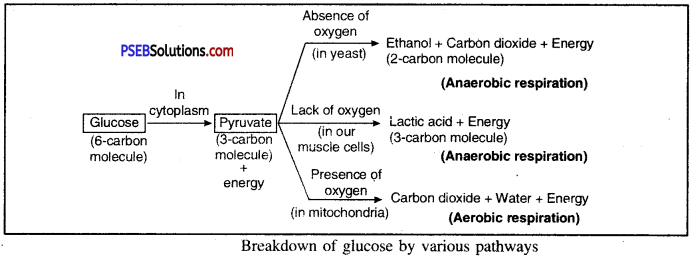
Question 12.
How is oxygen and CO2 transported in human beings?
Answer:
1. Transport of oxygen: It is transported from respiratory organs to body cells,
1. Haemoglobin helps in the transport of oxygen. In the alveoli of the lungs, the haemoglobin (Hb) present in red blood corpuscles combines with oxygen to form oxyhaemoglobin. When the blood reaches the tissue, oxygen is released from the oxyhaemoglobin for the consumption by the tissues.
Hb + O2 → HbO2
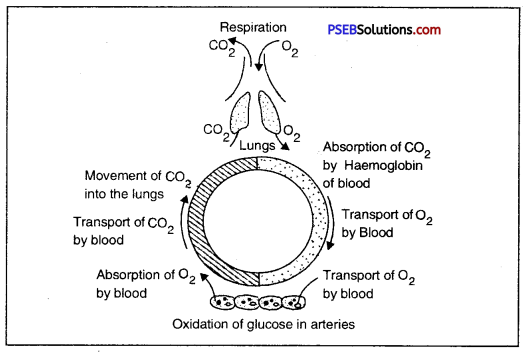
2. Some of O2 is transported in the solution form by plasma of blood.
2. Transport of CO2
- CO2 diffuses into blood plasma to form physical solution.
- CO2 forms unstable carbonic acid with water and is transported as such.
- CO2 is also transported from tissue to lungs as bicarbonates.
Question 13.
How are lungs designed in human beings to maximise the area for exchange of gases?
Answer:
Within the lungs, the primary bronchi divides into smaller and smaller tubes which finally terminate into balloon-like structures called alveoli. These alveoli increase the surface area for exchange of gases. There are 750 million alveoli in the lungs of man. If the alveolar surface is spread out it would cover about 80 m2. Thus it makes efficient exchange of gases.
Each alveolus or air sac has a diameter of 75 to 300 microns and has a very thin wall. The walls of the alveoli are elastic and are supplied with capillaries. Through these thin walls gases are exchanged between the capillaries and the air sacs.
Question 14.
What are the components of the transport system in human beings? What are the functions of these components?
Answer:
There are two main transport systems in human beings :
- Blood vascular system.
- Lymphatic system.
Components of blood vascular system
- Blood: It is a reddish viscous fluid connective tissue. In an adult human being, it is 5-6 litres in amount. Blood consists of two parts – plasma and formed elements. (RBCs, WBCs and blood platelets). Blood transports digested food, oxygen, carbon dioxide, nitrogenous wastes and hormones in the body.
- Heart: It is a hollow, muscular pumping organ. The heart sends the blood to lungs. Heart pumps the blood in the body.
- Blood vessels: The blood vessels which carry oxygenated blood are called arteries. They divide to form capillaries of finer dimensions. Exchange of materials takes place across the capillaries. It is possible because the walls of capillaries are extremely thin. The blood from the tissues is returned by veins.
Components of Lymphatic system
- Lymph: It acts as middle man between blood and tissue. It destroys harmful bacteria
- Lymph vessels
- Lymph capillaries
- Lymph nodes
Question 15.
Why is it necessary to separate oxygenated and deoxygenated blood in mammals and birds?
Answer:
- In the heart of these organisms the left side has oxygenated blood and right side deoxygenated blood.
- The separation of blood allows a highly efficient supply of oxygen to the body.
- It is essential for such animals which have high energy needs.
- They also constantly use energy for maintaining body heat.
Question 16.
What are the components of transport system in highly organised plants?
Answer:
Components of transport system in plants
- Xylem tissue. Vessels and tracheids of roots, stems and leaves are concerned with transport of water and minerals in plants.
- Phloem consists of sieve tubes and companion cells. It transports food, amino acid, phytohormones and other substances from leaves to various parts of plants.
Question 17.
How are water and minerals transported in plants?
Answer:
Transport of water and minerals
1. In xylem tissue, vessels and tracheids of the roots, stems and leaves are interconnected to form a continuous system of water conducting channels reaching all parts of the plants.
2. Plants absorb water and minerals through their entire surface i.e., roots, stem and leaves. However, mainly the water is absorbed by roots from soil.
3. The area of young roots where most of the absorption takes place is the root hair zone.
4. This zone is the area of greatest permeability.
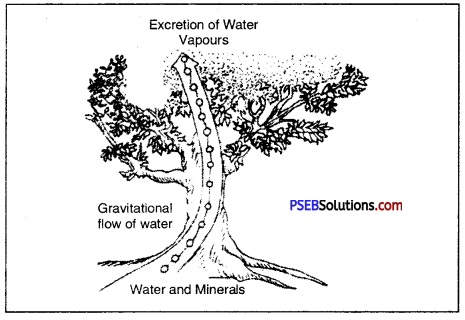
5. Passage of water in root or pathway of water in root
- The entry of water into the root hair dilutes the cell sap. Thus water molecules in root hair increase as compared to adjacent cortical cells.
- Water reaches the passage cells of endodermis. These passage cells lie opposite the xylem.
- They allow water to entre the pericycle.
- So, water enters the xylem from pericycle for upward movement of sap.
6. The Ascent of Sap:
The upward movement of water from the root towards the top of the plant in the xylem vessels is called ascent of sap. The upward transport of water and minerals in plants which are in some cases as tall as 400 ft. poses a serious problem.
7. Transpiration also helps in the absorption and upward movement of water and minerals dissolved in it from roots to the leaves.
Question 18.
How is food transported in plants?
Answer:
Transport of food in plants:
The food prepared in the green leaves of plants is transported through phloem in the form of sucrose solution to storage organs of roots, seeds and fruits. This process is called translocation. This process requires energy. It is provided by ATP molecules. This increases the osmotic pressure in the tissue causing water to move into it. This pressure moves the material in the phloem to tissues which have less pressure.
![]()
Question 19.
Describe the structure and functioning of nephron.
Or
How does urine formation occur in human?
Answer:
Structure of a Nephron:
A nephron is made up of:
- a globular double-walled Bowman’s capsule around a clump of capillaries or glomerulus, and
- a tubule surrounded by blood capillaries.
The tubule consists of
(a) a proximal convoluted portion
(b) the loop of Henle, with descending and ascending limbs, and
(c) a distal convoluted part.
The nephron empties into a collecting duct. The two million nephrons of a human being, end to end would extend for nearly 80 km. All the collecting ducts discharge into a central cavity of the kidney (pelvis) that connects to the ureter.
Functioning of Nephron
Urine is formed by 3 processes: glomerular filtration, tubular reabsorption and tubular secretion in the nephrons of the kidney.
1. Ultrafiltration (Glomerular filtration):
Blood is filtered under pressure in the glomeruli present in the cup-like structure of Bowman’s capsule. Glomerular (nephric) filtrate is formed.
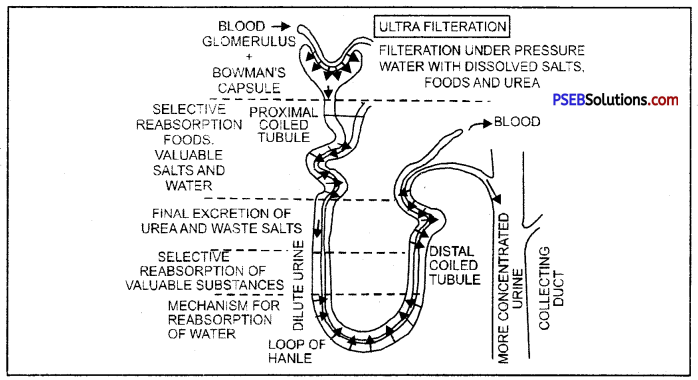
Nephron and its function
2. Tubular reabsorption:
In the PCT, entire glucose, amino acids, vitamins and hormones, most of the inorganic ions are reabsorbed by active transport, most of water by osmosis, and some urea by back diffusion from nephric filtrate.
Loop of Henle mainly concentrates urine to conserve water. Here, some inorganic ions are actively taken up and some water leaves by osmosis.
3. Tubular secretion:
In the DCT, collecting tubule and collecting duct, many ions, water (depending upon availability) are secreted in to DCT and collecting duct.
Urine formed passes into bladder from kidney through ureters.
Question 20.
What are the methods used by plants to get rid of excretory products?
Answer:
Excretory products of plants include CO2, salts, resins, tanins latex etc. Excretion in Plants
- Excess of water passes out during transpiration.
- Plants get rid of dead tissue as a measure to eliminate waste.
- Waste products may be stored in cellular vacuoles.
- Waste products may be stored in leaves which fall off.
- Resins and gums are stored in old xylem.
- Plants also excrete wastes into soil.
- Aquatic plants lose their waste products by diffusion into the water.
Question 21.
How is the amount of urine produced regulated?
Answer:
- Amount of urine formed depends upon the availability of water in the body.
- ADH (Antidiuretic Hormone) regulate the amount of water.
- Osmoregulation helps in regulation of salts and water.
- Urine is stored in urinary bladder.
